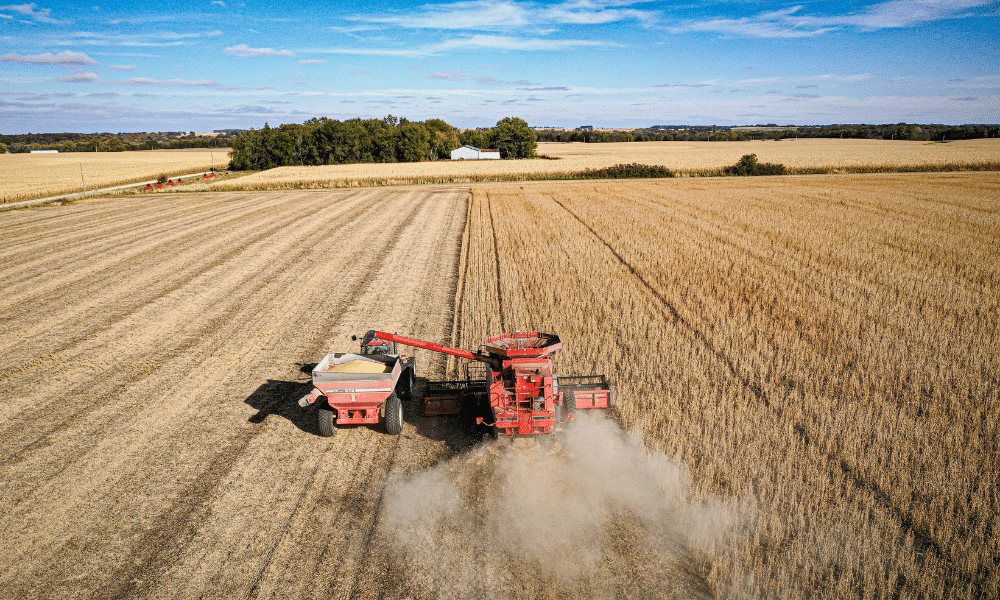
No matter the delivery method, customers can count on U.S. soybean farmers for all of their soy needs. (Joseph L. Murphy/Iowa Soybean Association)
Event highlights reliability of U.S. soy
October 12, 2020 | Bethany Baratta
Rich, fertile fields and a large geography in which to grow, transport and export soybeans makes the U.S. an ideal supplier of soy to the rest of the world.
Two oceans allow U.S. exports to reach foreign markets. Six, Class 1 railroads and fleets of trucks allow for efficient transportation of soybeans from fields and cooperatives to markets.
“I’m really proud when we load these barges,” says Iowa Soybean Association (ISA) board member Robb Ewoldt, in remarks to 1,000 customers from 69 countries during the virtual U.S. Soy Global Trade Exchange and Specialty Grains Conference.
Living four miles from the river, the terminal to the Mississippi River is a key link between Ewoldt’s farm and customers around the world. Investments in infrastructure are critical to maintaining relationships with customers around the globe.
A $2 million checkoff investment into the research, planning, analysis and design helped launch a key infrastructure project. The Mississippi River Deepening Project will dredge the lower Mississippi River from 45 feet to 50 feet. A deeper river will allow both larger ships and current vessels to be loaded with more revenue-producing freight, according to the Soy Transportation Coalition. It will also support soybean prices for U.S. farmers due to intermodal competition.
This is an important investment as 60% of U.S. soybean exports are shipped from ports along the lower Mississippi River. Completion of the dredging project, slated for 2024, means a 10- to 12-cent basis improvement for Ewoldt, who farms near Davenport.
“Ninety percent of our production goes out on a barge,” Ewoldt says. “We realize this is a world market now, and we want to grow the best crop we can because we know that in 20 minutes from this field we could be at a barge terminal loading it.”
Opportunity Springs From Chaos
Uffe Ostegaard, president for shipping company Hapag-Lloyd’s North American operations, says the COVID-19 pandemic has created disruptions in the supply chain. But from chaos comes opportunity to improve.
“We’re working toward quality in the supply chain,” Ostegaard says. “We have a very good integrated supply chain in terms of capacity, frequency, reliability and cost compared to a lot of other markets, and we see the U.S. as being a very good place to work from.”
The company is working to improve the speed and overall quality of its shipments. A new online tool connects customers to more proactive information on container shipments.
Peter Friedmann, executive director of the Agriculture Transportation Coalition, predicts ocean freight rates to remain stable. He notes that investments in infrastructure are vital to soy export success.
“We must deliver our superior products to foreign markets affordably and dependably,” Friedmann says. “Otherwise foreign buyers will find another source somewhere else in the world.”
Gene Seroka, executive director of the Port of Los Angeles, is a proponent for enhanced communications, which will better line up trucking, rail and container shipments for faster, more efficient delivery.
Count on U.S.
No matter the delivery method, customers can count on U.S. soybean farmers for all of their soy needs, says Ted McKinney, U.S. Under Secretary of Agriculture for Trade and Foreign Agricultural Affairs. He highlights four main areas in which U.S. soybeans are superior:
- Composition: “The types of soybeans we produce here are second to none around the world, and we’re always chasing that better bean,” McKinney says. Exceptional composition, whether for livestock, aquatics or food processing, is evident in U.S.- grown soy.
- Consistent supply: Customers around the globe need a reliable and consistent supply of soybeans, and you can count on the U.S. to deliver.
- Sustainably produced: Technology has reduced our need to walk beans, as McKinney did growing up on the family farm near Tipton, Indiana. “For areas around the world where sustainability has become very important, even paramount, you can count on it, and we can prove it with U.S. soybeans,” McKinney says.
- Innovation beyond the bushel: “We’re not stopping now with the presumption that soybeans are just for livestock and aquatics,” McKinney says. “It goes way, way beyond that.”
Though COVID-19 halted opportunities to travel to international customers, Ewoldt remains committed to raising GMO and non-GMO soybeans for customers around the world.
“I’ve been down to the Gulf and watched ships being loaded for customers around the world,” Ewoldt says. “I think it’s just amazing that the beans I’m growing this season will be in Japan next year being turned into protein for the Japanese people. It’s a feeling that’s hard to explain to someone else but knowing that you’re feeding a country, such as Japan, is really a neat thing.”
He says he can hardly wait to welcome international customers again on his farm.
“If you ever have the opportunity to come to Iowa, our door is always ope, and we welcome the opportunity to meet you and stand in this very field and talk about soybeans.”
This story was originally published in the October 2020 issue of the Iowa Soybean Review.
Back